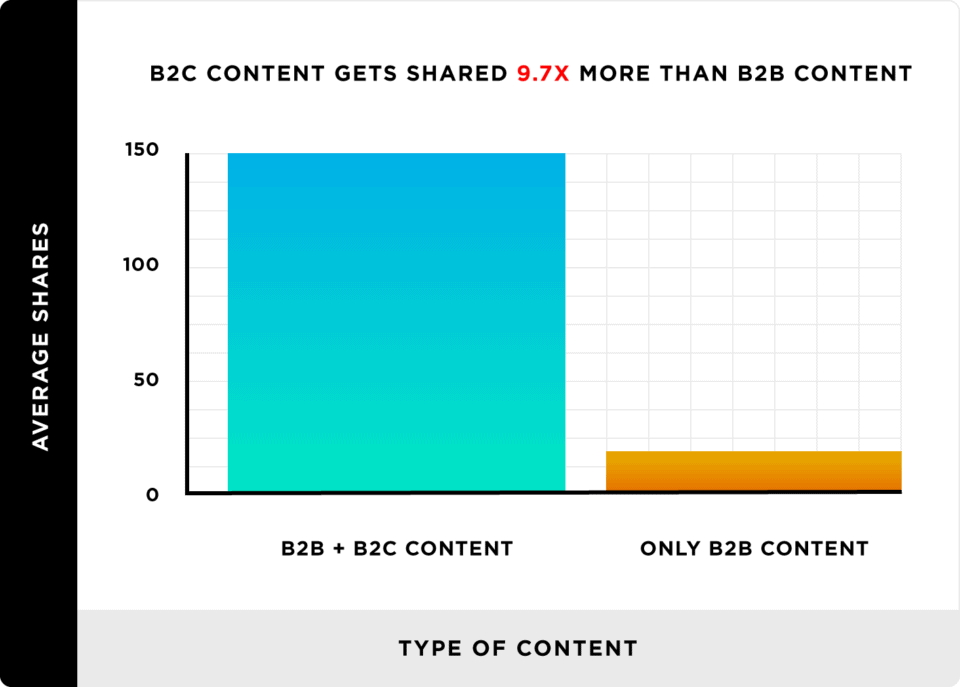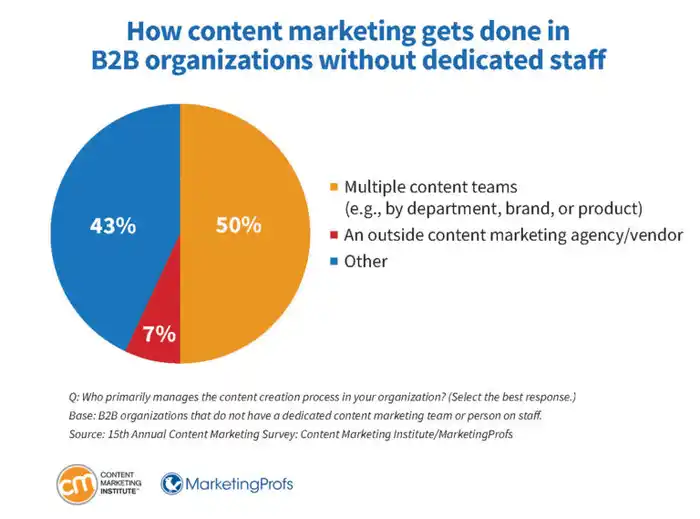Listen to article
“Is your content strategy firing on all cylinders, or is it falling flat?”
In today’s fast-paced digital world, it’s not just about what content you create, but also about the content publishing timing and platform. Knowing when and where to publish content can significantly impact its reach and effectiveness, converting potential views into loyal customers.
Did you know that B2B and B2C companies utilize blogs, budgets, and social media very differently? Or that LinkedIn is considered the most valuable social media platform by 84% of B2B marketers?
In this article, we’ll uncover key statistics about B2B vs. B2C blogging, content budget allocation, channel distribution strategies, and the impact of social media. Let’s dive in and discover how to optimize your content strategy for maximum impact.
Tailoring Blogging Strategies for B2B vs. B2C Success

Source: Backlinko
When it comes to blogging, the strategies for B2B and B2C marketers diverge sharply, and for good reason. B2B content often targets niche audiences with longer decision-making cycles, while B2C blogs aim to captivate and engage broad consumer bases with shareable, relatable content. By understanding these dynamics, marketers can allocate their resources effectively to create content that resonates and drives results.
- 75% of B2B marketers include blogging as part of their social media content strategy, compared to 61% of B2C marketers. Source
- B2C blog posts receive substantially higher engagement, achieving 9.7 times more shares than B2B blog content on average. Source
- For B2B, only 2% of articles generate 75% of social shares, underscoring the need to create standout, high-quality pieces to achieve virality. Source
Key Takeaway
The data highlights a crucial insight: while B2B marketers rely heavily on blogs to educate and influence decision-makers, B2C blogs thrive on shareability and mass appeal. For B2B, the focus should be on crafting a smaller number of highly impactful articles that align with the specific needs and challenges of their target audience. On the other hand, B2C brands can leverage diverse, emotionally compelling content to amplify social engagement and build brand loyalty.
Pro Tip:
To boost performance in both B2B and B2C blogging, prioritize data-driven insights. For B2B, analyze past content successes to identify themes and formats that drive shares, such as in-depth guides or thought leadership pieces. For B2C, focus on creating content with emotional hooks, visuals, or trending topics to spark more social shares and conversations.
For B2B marketers looking to refine their approach, adopting a comprehensive B2B website strategy can complement blogging efforts by ensuring every piece of content effectively guides decision-makers through the sales funnel.
How B2B Companies Are Strategically Allocating Content Marketing Budgets

Source: Content Marketing Institute
In B2B marketing, every dollar counts, and where you allocate your budget can significantly impact your content’s effectiveness. Budget trends reveal that companies excelling in content marketing don’t just invest more—they allocate resources strategically based on their maturity in content marketing. These insights can help guide your own budget planning to yield maximum ROI and stay competitive within the dynamic B2B landscape. Here are some key statistics to consider:
- B2B organizations, on average, dedicate 26% of their marketing budget to content marketing. Source
- High-performing B2B companies allocate a robust 40% of their marketing budget (excluding staffing costs) to content marketing, while those with lower success rates only invest 14%. Source
- Budget allocation increases with content marketing maturity: organizations in the mature phase allocate 33% of their budget, compared to 25% in the adolescent phase and 19% in the early stages. Source
- Looking ahead, 46% of B2B marketers expect their content marketing budget to remain steady, while 38% anticipate an increase. Source
Key Takeaway
The data underscores a key insight: achieving content marketing success in B2B isn’t just about allocating a percentage of your budget—it’s about ensuring your investment aligns with your organization’s goals and market position. Mature content marketing strategies demand higher investments because they focus on sophisticated tactics like personalization, advanced analytics, and integrated campaigns that drive meaningful engagement. If your budget allocation lags behind industry benchmarks, it may be time to reevaluate and prioritize content marketing as a core business growth driver.
Pro Tip:
Don’t just focus on budget percentage—focus on efficiency and look up the latest content marketing trends. Regularly audit your content marketing efforts to ensure funds are being allocated to high-impact initiatives. Diversify your spend by investing in scalable tools, repurposing high-performing content, and exploring emerging formats like interactive content or AI-driven campaigns to maximize returns without overspending.
Optimizing B2B Content Distribution: Insights into Channel Strategies
In the competitive B2B landscape, great content is only half the battle—effective distribution is what sets successful organizations apart. Selecting the right mix of channels ensures your content doesn’t just exist but thrives, reaching your target audience in the most impactful way. With diverse options like email, social media, and events, finding the balance between traditional formats and emerging trends can turn a good campaign into a great one. Let’s break down what the numbers reveal about top-performing channel strategies.
- Email remains the leading distribution channel, with 93% of B2B marketers choosing it as their go-to platform. Social media follows closely at 92%, along with blogs (79%), in-person events (56%), and webinars/webcasts/virtual events (55%). Source
- High-performing B2B organizations distribute content across an average of five formats, while their less successful counterparts only utilize four. Source
- The most successful B2B marketers strategically leverage all five top-performing formats—email, social media, blogs, events, and webinars—to drive results. Source
- Underutilizing distribution channels can hinder performance, as less successful brands tend to stick to fewer formats, limiting their reach and engagement opportunities. Source
Key Takeaway
A comprehensive, multi-channel approach is no longer optional in B2B marketing—it’s the standard for success. Marketers should view each format not as a standalone strategy but as a complement to others, creating a cohesive ecosystem of engagement. By diversifying your content delivery methods, you can meet your audience where they already are—whether that’s in their inboxes, on social media, or at an event.
Pro Tip:
Don’t just stick to tried-and-true channels—track performance metrics for each format and adapt over time. For example, if webinars consistently bring in leads, consider supplementing them with podcasts or LinkedIn Live to expand your audience while staying within the same theme of real-time engagement. For those looking to create a seamless and scalable strategy across channels, full-service marketing solutions can provide the expertise needed to elevate your efforts.
Why Social Media is the Cornerstone of B2B Marketing Success
Social media isn’t just a “nice-to-have” in B2B content strategy—it’s a game-changer. Offering unparalleled reach and engagement opportunities, it allows brands to connect with decision-makers, nurture leads, and drive conversions at every stage of the funnel. With the dominance of professional platforms like LinkedIn, there’s no question that social media has become the backbone of successful B2B marketing strategies.
- Over the past year, 90% of B2B marketers have used social media platforms to distribute content, making it the most popular distribution channel. Source
- Social media is the top channel for both top-of-funnel (50%) and bottom-of-funnel (46%) goals in B2B marketing, surpassing email and other channels in effectiveness. Source
- LinkedIn is considered the most valuable social media platform by 84% of B2B marketers. Source
- 90% of bloggers utilize social media to promote their blog content. Source
- An overwhelming 92% of content marketers consider LinkedIn the premier platform for content promotion. Source
Key Takeaway
From expanding reach to nurturing leads, the potential of social media in B2B marketing is undeniable. Platforms like LinkedIn offer a unique advantage, bridging the gap between content creation and audience engagement. However, success lies not just in using these platforms but in leveraging them strategically.
Pro Tip:
To stand out in the increasingly competitive B2B social media space, prioritize relationship-building over promotion. Share thought leadership content, engage in meaningful conversations, and use advanced targeting tools to connect with key decision-makers effectively.
Conclusion
The data underscores a fundamental truth: the timing, frequency, and distribution of your content can make or break your marketing strategy. From the disparity in B2B and B2C blogging impact to the power of strategic budget allocation and channel diversification, the statistics reveal a roadmap for optimizing content efforts. For B2B marketers, it’s not just about producing content—it’s about creating high-impact, shareable posts that resonate with a professional audience. Meanwhile, leveraging the right distribution channels, like LinkedIn and email, can amplify your efforts and drive measurable results.
Whether you’re fine-tuning your blogging frequency or reallocating your marketing budget, the key takeaway is clear: strategic content publishing elevates your brand and strengthens its reach. By understanding these trends and adapting them to your unique goals, you position your business for sustainable growth in a competitive landscape.
Ready to boost your traffic and grow your website? Your customers are looking for you, and our SEO services can help you be found across search engines. Let’s turn your content strategy into a success story.
About What the Stats Say About When and Where to Publish Content
This guide was written by the Scopic Studios team and reviewed by Araksya Hakobjanyan, SEO Lead at Scopic Studios.
Scopic Studios delivers exceptional and engaging content rooted in our expertise across marketing and creative services. Our team of talented writers and digital experts excel in transforming intricate concepts into captivating narratives tailored for diverse industries. We’re passionate about crafting content that not only resonates but also drives value across all digital platforms.
Note: This blog’s feature image is sourced from Freepik.































































































































































































































